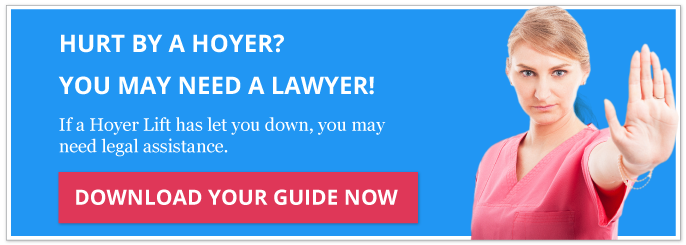Part 1 in an 8-part series
A Hoyer Lift is a type of patient lift used as an assistance device in hospitals and nursing homes or for people receiving health services at home. Healthcare workers use Hoyer Lifts to transfer patients between their beds and chairs or between other locations when the patient’s mobility is limited. The devices typically lifting the patient using electrical or hydraulic power from the floor or overhead (suspended from the ceiling, wall, or overhead tracks).
While the Hoyer Lift is designed to allow patients to be transferred while reducing the chance of stress or orthopedic injury on caregivers, these devices can also result in serious injury, particularly if the devices are used improperly, or malfunction or are poorly maintained.
Negligence and Hoyer Lift Injuries
Unfortunately, given how enormous the issue of mobility is in every nursing home and in many hospitals around the country, fall-related injuries and deaths are a severe risk to patients and can impact workers, as well. This can become especially problematic when it comes to Hoyer Lifts if the staff has not been properly trained on how to use them and other mechanical devices and/or if those devices have been poorly maintained and could thus breakdown while in use.
Many of these injuries are preventable, but it is important that nursing homes and hospitals do the following in order to ensure that both staff and patients are safe when using these devices:
- Properly maintain all Hoyer Lifts to avoid malfunction and subsequent injury. This includes inspecting slings and repairing them if need be;
- Make sure there is enough staff involved in using these devices to lift or re-position or to transport patients. No staffer should be placed in a position of having to use one on their own; and
- Properly train all staff on how to use Hoyer Lifts, including how to properly attach the sling and seat the resident. Failing to do so could result in everyone involved getting injured.
In particular, if a caregiver pushes, pulls, or lifts weight while off-balance, leaning forwarding twisting, reaching, and/or entrapped in a confined space, it can result in serious back injuries to the caregiver. In addition, hospitals and nursing home should have a policy of a minimum of two people working together while operating and during the use of a Hoyer Lift. Patients can get agitated, start to struggle and the sling could break, or the machine could stop working, allowing the patient to fall on a staffer. Given that Hoyer Lifts are frequently used to transport obese patients, this can result in serious injuries to both the staffer and patient.
Hoyer Lift Injuries and Workers’ Compensation
According to the Occupational Health and Safety Administration (OSHA), most worker injuries in nursing homes and related facilities are caused by lifting, reaching, and bending, leading to back injuries and shoulder injuries. Specifically, more than half of time taken off due to injuries are for those classified as sprains or strains. Some of these include:
- Bruises;
- Soreness;
- Fractures;
- Multiple trauma;
- Cuts and punctures;
- Repetitive injuries;
- Herniated discs;
- Lower back strain;
- Lumbar sprains; and
- Torn rotator cuffs.
When it comes to hospital worker injuries that result in taking time off from work, nearly half are caused by overexertion or bodily reaction, including lifting, bending, reaching, or slipping without falling; all motions that often relate to patient handling, including contact with equipment like Hoyer Lifts.
Fortunately, healthcare workers in Pennsylvania and other states who suffer work injuries while using Hoyer Lifts and in other capacities may be eligible to receive workers’ compensation benefits to cover their subsequent medical bills and any lost wages.
What is workers’ compensation? All employers are required to provide workers’ compensation for employees in case they get injured on the job. These benefits typically include coverage of medical care expenses, compensation for any lost wages for missed work, and compensation for dependent family members, if there is a worker death.
Injured On-the-Job Using a Hoyer Lift? Hire a Work Injury Lawyer
If you or a loved one was injured while using a Hoyer Lift on the job, you need to speak with an experienced workers’ compensation attorney right away. It is crucial that you follow specific steps when it comes to ensuring that you and your family are covered when it comes to getting injured on the job, and your attorney can ensure that you follow all of these steps so that you are on track to receive workers’ compensation.
At Krasno Krasno & Onwudinjo, our Pennsylvania workers’ compensation attorneys have dedicated themselves to protecting workers who have been injured on the job. Contact us today by calling 800.952.9640 or get in touch online to find out how we can help you.
Disclaimer: This content is considered advertising and does not constitute any client-attorney privilege and does not offer any advice or opinion on any legal matter.






